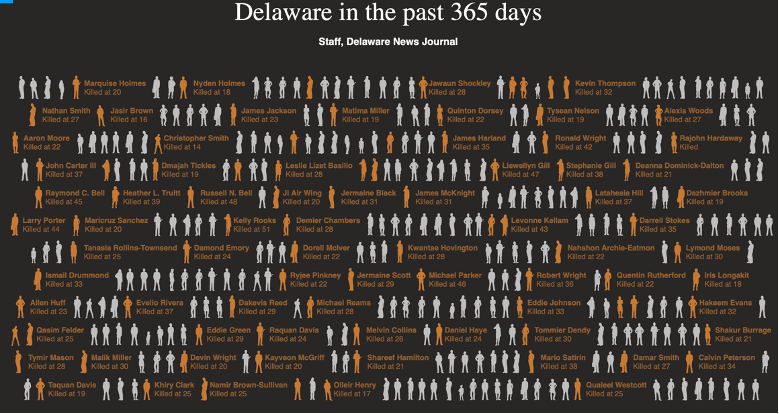Gun violence in Delaware has been bad for a really long time (Perhaps you might remember the "Murder Town USA" moniker applied to Wilmington by Newsweek magazine back in 2014.). In desperation, Wilmington's City Council asked the Center for Disease Control (CDC) for a health assessment of the city and to make recommendations to solve the problem. In 2015 the CDC issued a lengthy report with numerous recommendations (largely shelved).
And six years on, the violence grows and further threatens Delaware's reputation and quality of life.
Delaware and the City of Wilmington's policy leaders have been looking in the wrong places for solutions to gun violence. In fact, the policies implemented by Delaware's government might have actually led to this violence because these policies have destroyed the foundations upon which successful long-term poverty eradication, and therefore, violence eradication rests.
A Thought Experiment - Delaware's "Failure Sequence"
Let's try a brief thought experiment. Imagine dropping out of high school (think back to your 16-year-old self) - and when you dropped out, you were two, four, or even eight years behind "grade level" (specifically, imagine your 16-year-old self with only a 4th-grade education).
Further, imagine that you had been raised by a well-meaning, single parent who also missed out on an education, rarely held a job, and never married, and had always been receiving some type of welfare without work requirements.
Finally, imagine that you cannot get a job because few employers will risk paying a high school drop-out Delaware's minimum wage (which will soon equate to a $30,000 per year salary.).
So, put yourself in the position of no education, no family support structure, and no job opportunities while living in a neighborhood where everyone else is in the same position as you. What would you do at the age of 18, 20, or 25 years old? You have to eat and clothe yourself - indeed, you want to survive.
Suddenly, the idea of joining a gang and moving up the hierarchy of that gang by whatever means necessary starts to look like a good option.
This is Delaware's "Failure Sequence," and Delaware public policy actively supports it.
The "Success Sequence"
In 2009, Brookings Institution scholars Isabel Sawhill and Ron Haskins proposed a different model of social development. They called it the "Success Sequence." Sawhill and Haskins demonstrated from demographic data that if a person followed the "Success Sequence," they had a less than 5% chance of ending up in poverty. The sequence to success?
1. Graduate from high school,
2. Get a job - any job,
3. Get married prior to having any children.
That's it. A simple set of goals to create effective government policy that lifts thousands of Delawareans out of poverty, thereby reducing violence in our State.
Evidence that the "Success Sequence" works continues to roll in
Recognizing that Progressives were calling the "Success Sequence" racist and/or "old fashioned," in 2017, American Enterprise Institute scholars Brad Wilcox and Wendy Wang conducted a study to measure the impact of the "Success Sequence" on millennials.
Could they confirm the outcomes of the Success Sequence remain as effective as the original research discovered? According to Brad Wilcox, "We found that 97% of millennials who followed the success sequence are not poor and are in the middle-income track by age 30.
"Based on every indicator, from our perspective, the success sequence is still quite relevant and compelling." Dr. Wilcox goes on to state, "Fully 86 percent of young adults who married first have family incomes in the middle or top third. Compare that to only 53 percent of millennials who put childbearing before marriage."
The research also confirmed that the success sequence holds true for racial and ethnic minorities, as well as young adults in lower-income families with "76 percent of African American and 81 percent of Hispanic young adults who married first are in the middle or upper third of the income distribution."
Conclusion
A definition of insanity is doing the same thing over and over again while expecting a different result. According to this definition, Delaware's policymakers are insane. They pour more & more money into failed government-run schools with no evidence of improvement or accountability thereof.
They continually raise employment costs ensuring the young people cannot get jobs. They have turned a social safety net into a hammock - trapping families in a web of lost opportunity and gun violence.
The good news is that we know the policies that need to be in place for our young people to move out of and stay out of poverty - that is, get a high school education, get a job, and then get married prior to having children.
In our urban and rural settings, Delaware policymakers have made this sequence very hard to follow. The results of Delaware's failures are plain for all to see in the violence in our communities.
